Population, Poverty, and Inequality in Mumbai: A Sociological Analysis
VerifiedAdded on 2023/04/23
|13
|4302
|360
Essay
AI Summary
This essay delves into the critical issues of population growth, poverty, and inequality within the context of Mumbai, India. It explores the significant rise in urban populations, primarily driven by migration and high birth rates, and its consequential strain on limited resources, leading to widespread poverty and the proliferation of slums. The essay highlights the specific challenges Mumbai faces, including the growth of slums like Dharavi, and the impact of rapid urbanization on public infrastructure and social services. It examines the historical context of Mumbai's population growth, the role of economic opportunities, and the government's response to the influx of migrants. The analysis underscores the urgent need for sustainable urban planning, adequate housing, and social programs to address the escalating problems associated with overpopulation and inequality, offering a critical perspective on the city's development trajectory and the well-being of its residents. This essay provides an in-depth analysis of the key factors contributing to the challenges faced by Mumbai, including the impact of migration and the growth of slums, and the broader implications for urban development and social justice.
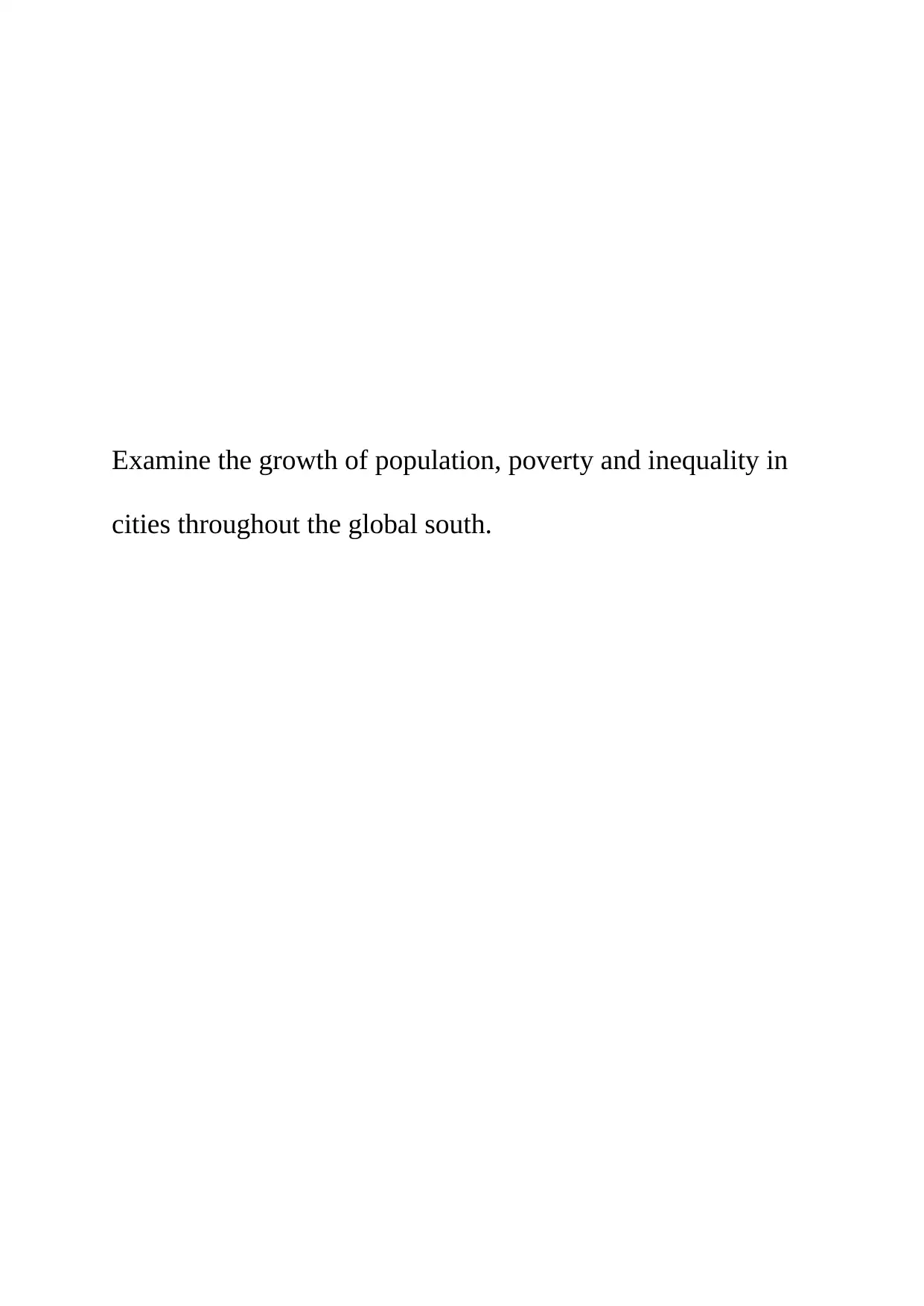
Examine the growth of population, poverty and inequality in
cities throughout the global south.
cities throughout the global south.
Paraphrase This Document
Need a fresh take? Get an instant paraphrase of this document with our AI Paraphraser
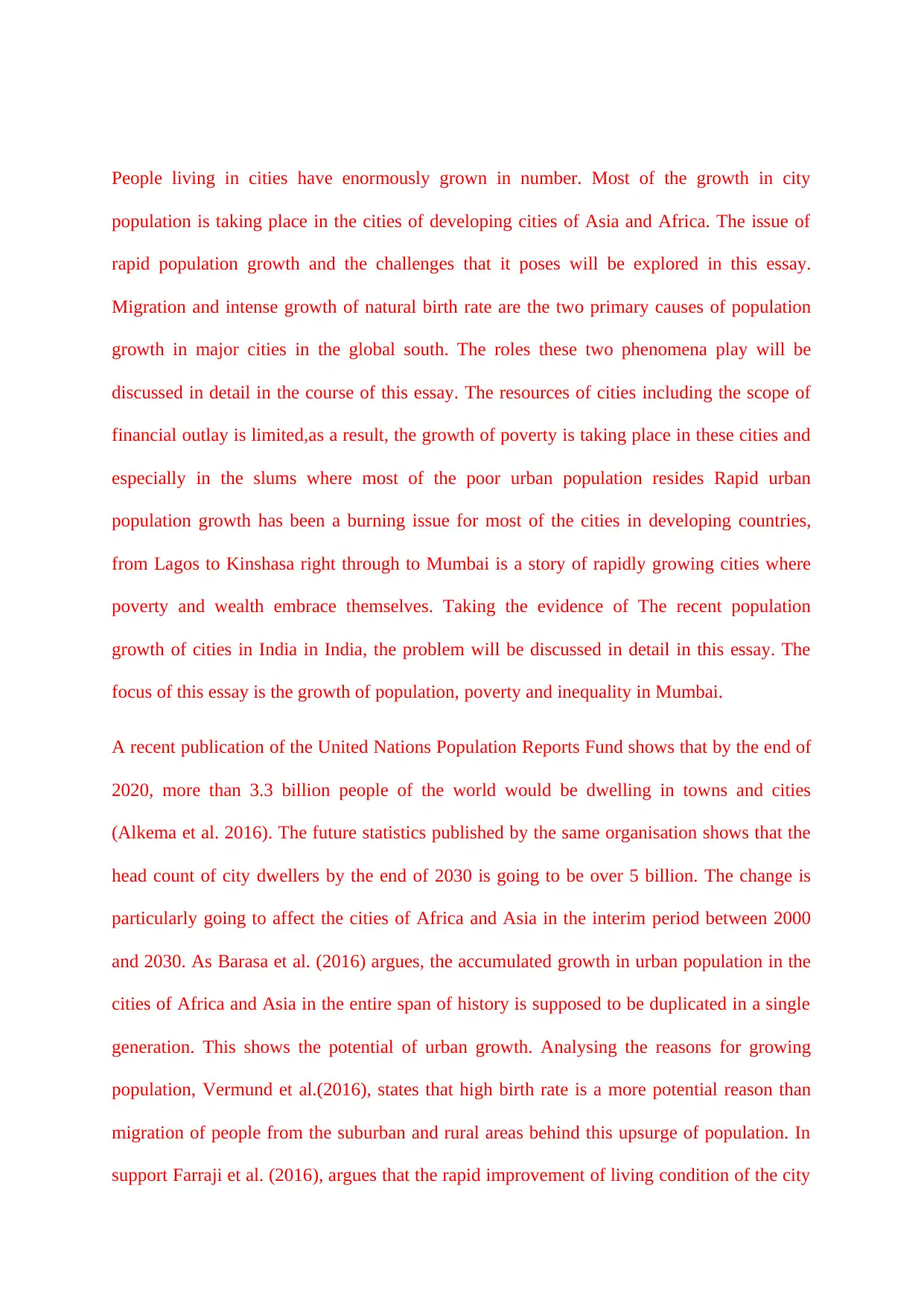
People living in cities have enormously grown in number. Most of the growth in city
population is taking place in the cities of developing cities of Asia and Africa. The issue of
rapid population growth and the challenges that it poses will be explored in this essay.
Migration and intense growth of natural birth rate are the two primary causes of population
growth in major cities in the global south. The roles these two phenomena play will be
discussed in detail in the course of this essay. The resources of cities including the scope of
financial outlay is limited,as a result, the growth of poverty is taking place in these cities and
especially in the slums where most of the poor urban population resides Rapid urban
population growth has been a burning issue for most of the cities in developing countries,
from Lagos to Kinshasa right through to Mumbai is a story of rapidly growing cities where
poverty and wealth embrace themselves. Taking the evidence of The recent population
growth of cities in India in India, the problem will be discussed in detail in this essay. The
focus of this essay is the growth of population, poverty and inequality in Mumbai.
A recent publication of the United Nations Population Reports Fund shows that by the end of
2020, more than 3.3 billion people of the world would be dwelling in towns and cities
(Alkema et al. 2016). The future statistics published by the same organisation shows that the
head count of city dwellers by the end of 2030 is going to be over 5 billion. The change is
particularly going to affect the cities of Africa and Asia in the interim period between 2000
and 2030. As Barasa et al. (2016) argues, the accumulated growth in urban population in the
cities of Africa and Asia in the entire span of history is supposed to be duplicated in a single
generation. This shows the potential of urban growth. Analysing the reasons for growing
population, Vermund et al.(2016), states that high birth rate is a more potential reason than
migration of people from the suburban and rural areas behind this upsurge of population. In
support Farraji et al. (2016), argues that the rapid improvement of living condition of the city
population is taking place in the cities of developing cities of Asia and Africa. The issue of
rapid population growth and the challenges that it poses will be explored in this essay.
Migration and intense growth of natural birth rate are the two primary causes of population
growth in major cities in the global south. The roles these two phenomena play will be
discussed in detail in the course of this essay. The resources of cities including the scope of
financial outlay is limited,as a result, the growth of poverty is taking place in these cities and
especially in the slums where most of the poor urban population resides Rapid urban
population growth has been a burning issue for most of the cities in developing countries,
from Lagos to Kinshasa right through to Mumbai is a story of rapidly growing cities where
poverty and wealth embrace themselves. Taking the evidence of The recent population
growth of cities in India in India, the problem will be discussed in detail in this essay. The
focus of this essay is the growth of population, poverty and inequality in Mumbai.
A recent publication of the United Nations Population Reports Fund shows that by the end of
2020, more than 3.3 billion people of the world would be dwelling in towns and cities
(Alkema et al. 2016). The future statistics published by the same organisation shows that the
head count of city dwellers by the end of 2030 is going to be over 5 billion. The change is
particularly going to affect the cities of Africa and Asia in the interim period between 2000
and 2030. As Barasa et al. (2016) argues, the accumulated growth in urban population in the
cities of Africa and Asia in the entire span of history is supposed to be duplicated in a single
generation. This shows the potential of urban growth. Analysing the reasons for growing
population, Vermund et al.(2016), states that high birth rate is a more potential reason than
migration of people from the suburban and rural areas behind this upsurge of population. In
support Farraji et al. (2016), argues that the rapid improvement of living condition of the city
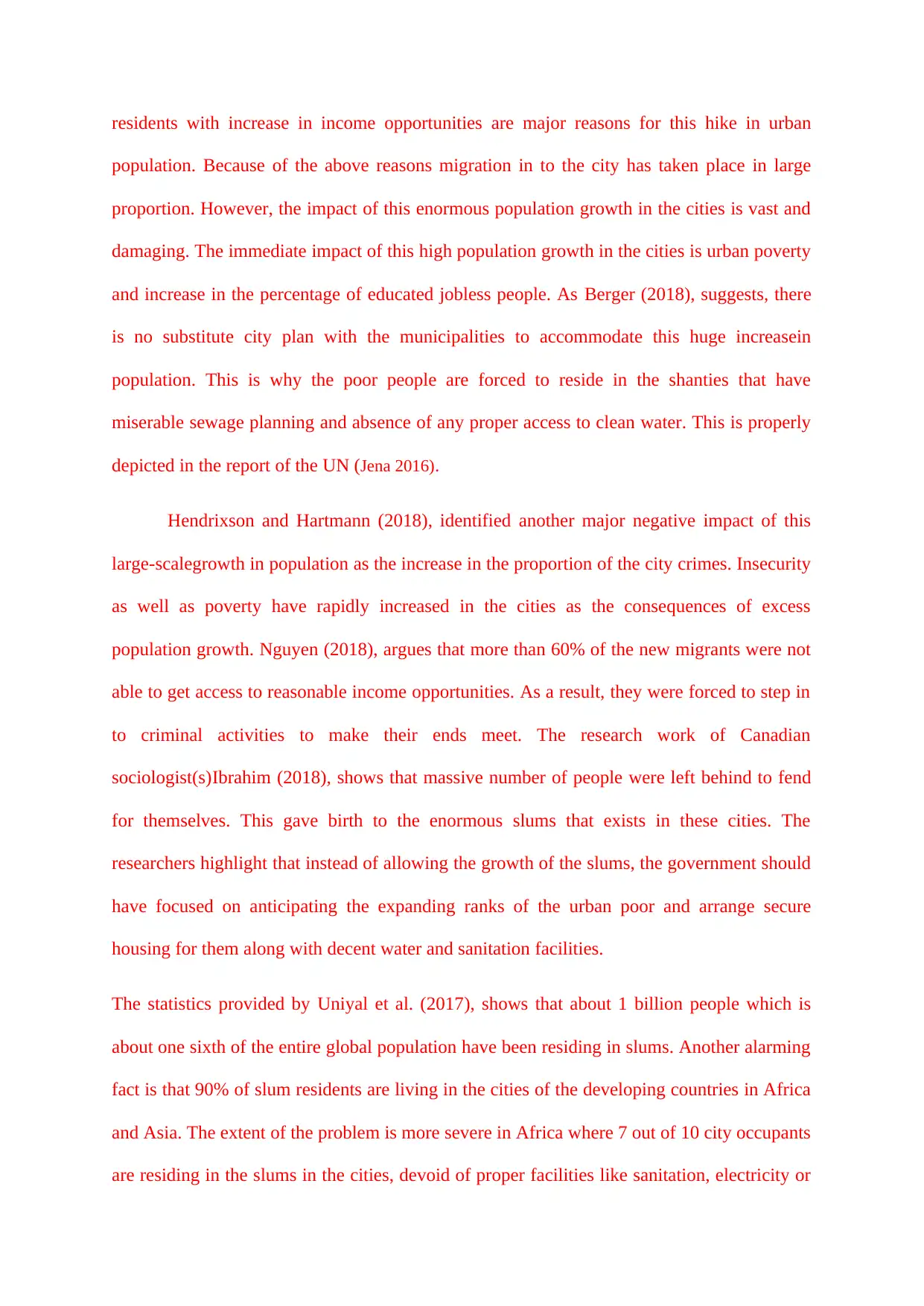
residents with increase in income opportunities are major reasons for this hike in urban
population. Because of the above reasons migration in to the city has taken place in large
proportion. However, the impact of this enormous population growth in the cities is vast and
damaging. The immediate impact of this high population growth in the cities is urban poverty
and increase in the percentage of educated jobless people. As Berger (2018), suggests, there
is no substitute city plan with the municipalities to accommodate this huge increasein
population. This is why the poor people are forced to reside in the shanties that have
miserable sewage planning and absence of any proper access to clean water. This is properly
depicted in the report of the UN (Jena 2016).
Hendrixson and Hartmann (2018), identified another major negative impact of this
large-scalegrowth in population as the increase in the proportion of the city crimes. Insecurity
as well as poverty have rapidly increased in the cities as the consequences of excess
population growth. Nguyen (2018), argues that more than 60% of the new migrants were not
able to get access to reasonable income opportunities. As a result, they were forced to step in
to criminal activities to make their ends meet. The research work of Canadian
sociologist(s)Ibrahim (2018), shows that massive number of people were left behind to fend
for themselves. This gave birth to the enormous slums that exists in these cities. The
researchers highlight that instead of allowing the growth of the slums, the government should
have focused on anticipating the expanding ranks of the urban poor and arrange secure
housing for them along with decent water and sanitation facilities.
The statistics provided by Uniyal et al. (2017), shows that about 1 billion people which is
about one sixth of the entire global population have been residing in slums. Another alarming
fact is that 90% of slum residents are living in the cities of the developing countries in Africa
and Asia. The extent of the problem is more severe in Africa where 7 out of 10 city occupants
are residing in the slums in the cities, devoid of proper facilities like sanitation, electricity or
population. Because of the above reasons migration in to the city has taken place in large
proportion. However, the impact of this enormous population growth in the cities is vast and
damaging. The immediate impact of this high population growth in the cities is urban poverty
and increase in the percentage of educated jobless people. As Berger (2018), suggests, there
is no substitute city plan with the municipalities to accommodate this huge increasein
population. This is why the poor people are forced to reside in the shanties that have
miserable sewage planning and absence of any proper access to clean water. This is properly
depicted in the report of the UN (Jena 2016).
Hendrixson and Hartmann (2018), identified another major negative impact of this
large-scalegrowth in population as the increase in the proportion of the city crimes. Insecurity
as well as poverty have rapidly increased in the cities as the consequences of excess
population growth. Nguyen (2018), argues that more than 60% of the new migrants were not
able to get access to reasonable income opportunities. As a result, they were forced to step in
to criminal activities to make their ends meet. The research work of Canadian
sociologist(s)Ibrahim (2018), shows that massive number of people were left behind to fend
for themselves. This gave birth to the enormous slums that exists in these cities. The
researchers highlight that instead of allowing the growth of the slums, the government should
have focused on anticipating the expanding ranks of the urban poor and arrange secure
housing for them along with decent water and sanitation facilities.
The statistics provided by Uniyal et al. (2017), shows that about 1 billion people which is
about one sixth of the entire global population have been residing in slums. Another alarming
fact is that 90% of slum residents are living in the cities of the developing countries in Africa
and Asia. The extent of the problem is more severe in Africa where 7 out of 10 city occupants
are residing in the slums in the cities, devoid of proper facilities like sanitation, electricity or
⊘ This is a preview!⊘
Do you want full access?
Subscribe today to unlock all pages.

Trusted by 1+ million students worldwide
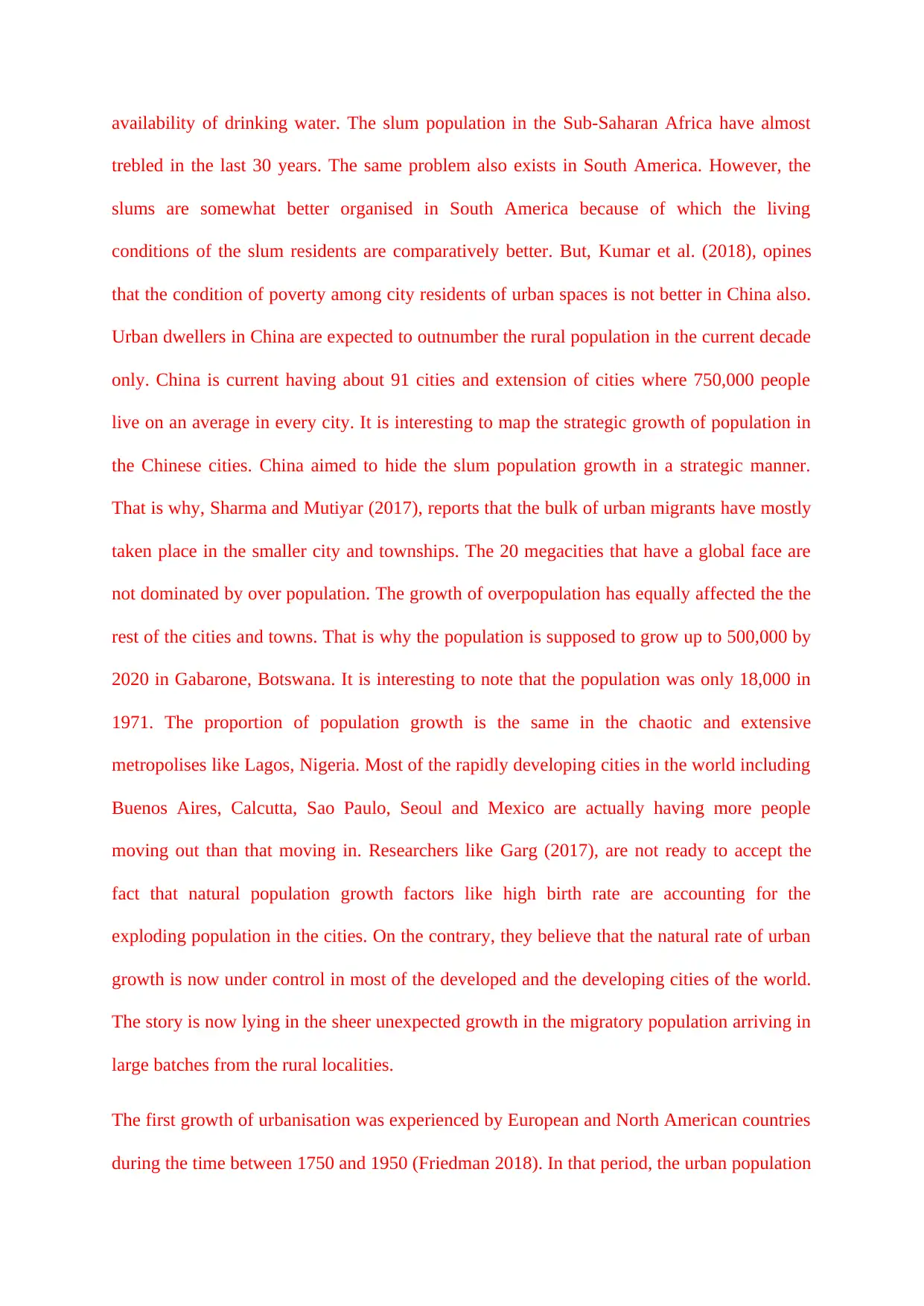
availability of drinking water. The slum population in the Sub-Saharan Africa have almost
trebled in the last 30 years. The same problem also exists in South America. However, the
slums are somewhat better organised in South America because of which the living
conditions of the slum residents are comparatively better. But, Kumar et al. (2018), opines
that the condition of poverty among city residents of urban spaces is not better in China also.
Urban dwellers in China are expected to outnumber the rural population in the current decade
only. China is current having about 91 cities and extension of cities where 750,000 people
live on an average in every city. It is interesting to map the strategic growth of population in
the Chinese cities. China aimed to hide the slum population growth in a strategic manner.
That is why, Sharma and Mutiyar (2017), reports that the bulk of urban migrants have mostly
taken place in the smaller city and townships. The 20 megacities that have a global face are
not dominated by over population. The growth of overpopulation has equally affected the the
rest of the cities and towns. That is why the population is supposed to grow up to 500,000 by
2020 in Gabarone, Botswana. It is interesting to note that the population was only 18,000 in
1971. The proportion of population growth is the same in the chaotic and extensive
metropolises like Lagos, Nigeria. Most of the rapidly developing cities in the world including
Buenos Aires, Calcutta, Sao Paulo, Seoul and Mexico are actually having more people
moving out than that moving in. Researchers like Garg (2017), are not ready to accept the
fact that natural population growth factors like high birth rate are accounting for the
exploding population in the cities. On the contrary, they believe that the natural rate of urban
growth is now under control in most of the developed and the developing cities of the world.
The story is now lying in the sheer unexpected growth in the migratory population arriving in
large batches from the rural localities.
The first growth of urbanisation was experienced by European and North American countries
during the time between 1750 and 1950 (Friedman 2018). In that period, the urban population
trebled in the last 30 years. The same problem also exists in South America. However, the
slums are somewhat better organised in South America because of which the living
conditions of the slum residents are comparatively better. But, Kumar et al. (2018), opines
that the condition of poverty among city residents of urban spaces is not better in China also.
Urban dwellers in China are expected to outnumber the rural population in the current decade
only. China is current having about 91 cities and extension of cities where 750,000 people
live on an average in every city. It is interesting to map the strategic growth of population in
the Chinese cities. China aimed to hide the slum population growth in a strategic manner.
That is why, Sharma and Mutiyar (2017), reports that the bulk of urban migrants have mostly
taken place in the smaller city and townships. The 20 megacities that have a global face are
not dominated by over population. The growth of overpopulation has equally affected the the
rest of the cities and towns. That is why the population is supposed to grow up to 500,000 by
2020 in Gabarone, Botswana. It is interesting to note that the population was only 18,000 in
1971. The proportion of population growth is the same in the chaotic and extensive
metropolises like Lagos, Nigeria. Most of the rapidly developing cities in the world including
Buenos Aires, Calcutta, Sao Paulo, Seoul and Mexico are actually having more people
moving out than that moving in. Researchers like Garg (2017), are not ready to accept the
fact that natural population growth factors like high birth rate are accounting for the
exploding population in the cities. On the contrary, they believe that the natural rate of urban
growth is now under control in most of the developed and the developing cities of the world.
The story is now lying in the sheer unexpected growth in the migratory population arriving in
large batches from the rural localities.
The first growth of urbanisation was experienced by European and North American countries
during the time between 1750 and 1950 (Friedman 2018). In that period, the urban population
Paraphrase This Document
Need a fresh take? Get an instant paraphrase of this document with our AI Paraphraser
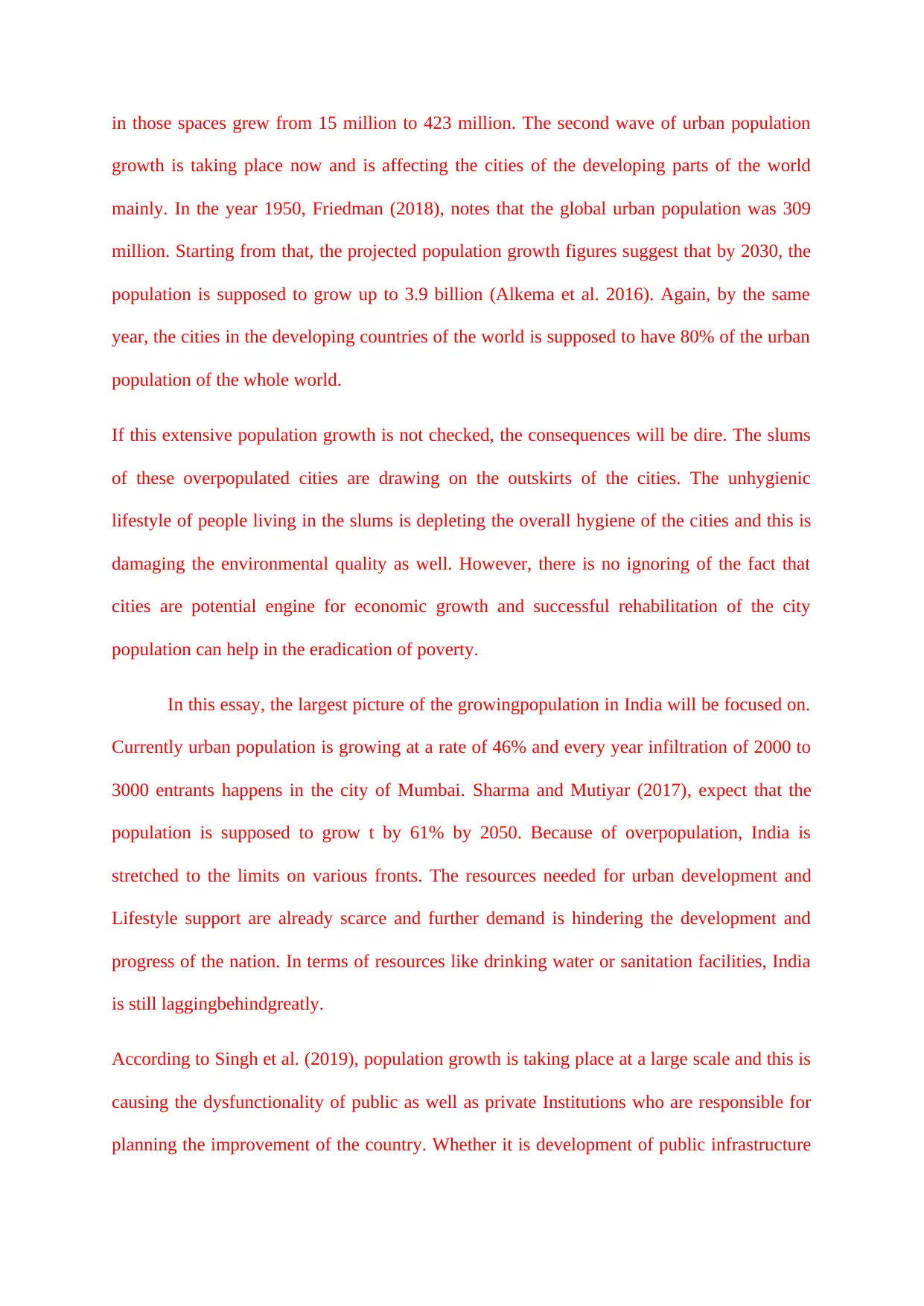
in those spaces grew from 15 million to 423 million. The second wave of urban population
growth is taking place now and is affecting the cities of the developing parts of the world
mainly. In the year 1950, Friedman (2018), notes that the global urban population was 309
million. Starting from that, the projected population growth figures suggest that by 2030, the
population is supposed to grow up to 3.9 billion (Alkema et al. 2016). Again, by the same
year, the cities in the developing countries of the world is supposed to have 80% of the urban
population of the whole world.
If this extensive population growth is not checked, the consequences will be dire. The slums
of these overpopulated cities are drawing on the outskirts of the cities. The unhygienic
lifestyle of people living in the slums is depleting the overall hygiene of the cities and this is
damaging the environmental quality as well. However, there is no ignoring of the fact that
cities are potential engine for economic growth and successful rehabilitation of the city
population can help in the eradication of poverty.
In this essay, the largest picture of the growingpopulation in India will be focused on.
Currently urban population is growing at a rate of 46% and every year infiltration of 2000 to
3000 entrants happens in the city of Mumbai. Sharma and Mutiyar (2017), expect that the
population is supposed to grow t by 61% by 2050. Because of overpopulation, India is
stretched to the limits on various fronts. The resources needed for urban development and
Lifestyle support are already scarce and further demand is hindering the development and
progress of the nation. In terms of resources like drinking water or sanitation facilities, India
is still laggingbehindgreatly.
According to Singh et al. (2019), population growth is taking place at a large scale and this is
causing the dysfunctionality of public as well as private Institutions who are responsible for
planning the improvement of the country. Whether it is development of public infrastructure
growth is taking place now and is affecting the cities of the developing parts of the world
mainly. In the year 1950, Friedman (2018), notes that the global urban population was 309
million. Starting from that, the projected population growth figures suggest that by 2030, the
population is supposed to grow up to 3.9 billion (Alkema et al. 2016). Again, by the same
year, the cities in the developing countries of the world is supposed to have 80% of the urban
population of the whole world.
If this extensive population growth is not checked, the consequences will be dire. The slums
of these overpopulated cities are drawing on the outskirts of the cities. The unhygienic
lifestyle of people living in the slums is depleting the overall hygiene of the cities and this is
damaging the environmental quality as well. However, there is no ignoring of the fact that
cities are potential engine for economic growth and successful rehabilitation of the city
population can help in the eradication of poverty.
In this essay, the largest picture of the growingpopulation in India will be focused on.
Currently urban population is growing at a rate of 46% and every year infiltration of 2000 to
3000 entrants happens in the city of Mumbai. Sharma and Mutiyar (2017), expect that the
population is supposed to grow t by 61% by 2050. Because of overpopulation, India is
stretched to the limits on various fronts. The resources needed for urban development and
Lifestyle support are already scarce and further demand is hindering the development and
progress of the nation. In terms of resources like drinking water or sanitation facilities, India
is still laggingbehindgreatly.
According to Singh et al. (2019), population growth is taking place at a large scale and this is
causing the dysfunctionality of public as well as private Institutions who are responsible for
planning the improvement of the country. Whether it is development of public infrastructure
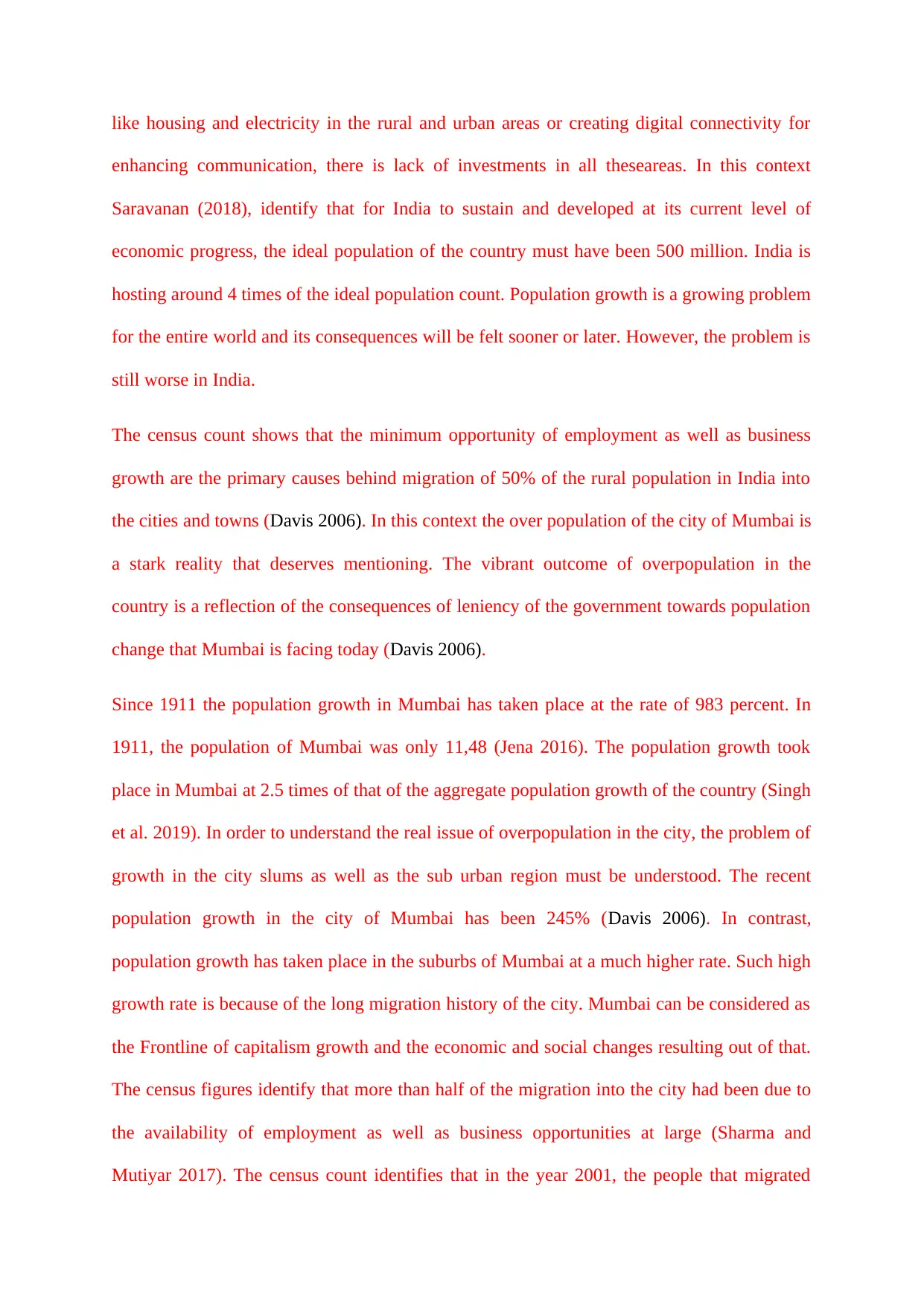
like housing and electricity in the rural and urban areas or creating digital connectivity for
enhancing communication, there is lack of investments in all theseareas. In this context
Saravanan (2018), identify that for India to sustain and developed at its current level of
economic progress, the ideal population of the country must have been 500 million. India is
hosting around 4 times of the ideal population count. Population growth is a growing problem
for the entire world and its consequences will be felt sooner or later. However, the problem is
still worse in India.
The census count shows that the minimum opportunity of employment as well as business
growth are the primary causes behind migration of 50% of the rural population in India into
the cities and towns (Davis 2006). In this context the over population of the city of Mumbai is
a stark reality that deserves mentioning. The vibrant outcome of overpopulation in the
country is a reflection of the consequences of leniency of the government towards population
change that Mumbai is facing today (Davis 2006).
Since 1911 the population growth in Mumbai has taken place at the rate of 983 percent. In
1911, the population of Mumbai was only 11,48 (Jena 2016). The population growth took
place in Mumbai at 2.5 times of that of the aggregate population growth of the country (Singh
et al. 2019). In order to understand the real issue of overpopulation in the city, the problem of
growth in the city slums as well as the sub urban region must be understood. The recent
population growth in the city of Mumbai has been 245% (Davis 2006). In contrast,
population growth has taken place in the suburbs of Mumbai at a much higher rate. Such high
growth rate is because of the long migration history of the city. Mumbai can be considered as
the Frontline of capitalism growth and the economic and social changes resulting out of that.
The census figures identify that more than half of the migration into the city had been due to
the availability of employment as well as business opportunities at large (Sharma and
Mutiyar 2017). The census count identifies that in the year 2001, the people that migrated
enhancing communication, there is lack of investments in all theseareas. In this context
Saravanan (2018), identify that for India to sustain and developed at its current level of
economic progress, the ideal population of the country must have been 500 million. India is
hosting around 4 times of the ideal population count. Population growth is a growing problem
for the entire world and its consequences will be felt sooner or later. However, the problem is
still worse in India.
The census count shows that the minimum opportunity of employment as well as business
growth are the primary causes behind migration of 50% of the rural population in India into
the cities and towns (Davis 2006). In this context the over population of the city of Mumbai is
a stark reality that deserves mentioning. The vibrant outcome of overpopulation in the
country is a reflection of the consequences of leniency of the government towards population
change that Mumbai is facing today (Davis 2006).
Since 1911 the population growth in Mumbai has taken place at the rate of 983 percent. In
1911, the population of Mumbai was only 11,48 (Jena 2016). The population growth took
place in Mumbai at 2.5 times of that of the aggregate population growth of the country (Singh
et al. 2019). In order to understand the real issue of overpopulation in the city, the problem of
growth in the city slums as well as the sub urban region must be understood. The recent
population growth in the city of Mumbai has been 245% (Davis 2006). In contrast,
population growth has taken place in the suburbs of Mumbai at a much higher rate. Such high
growth rate is because of the long migration history of the city. Mumbai can be considered as
the Frontline of capitalism growth and the economic and social changes resulting out of that.
The census figures identify that more than half of the migration into the city had been due to
the availability of employment as well as business opportunities at large (Sharma and
Mutiyar 2017). The census count identifies that in the year 2001, the people that migrated
⊘ This is a preview!⊘
Do you want full access?
Subscribe today to unlock all pages.

Trusted by 1+ million students worldwide
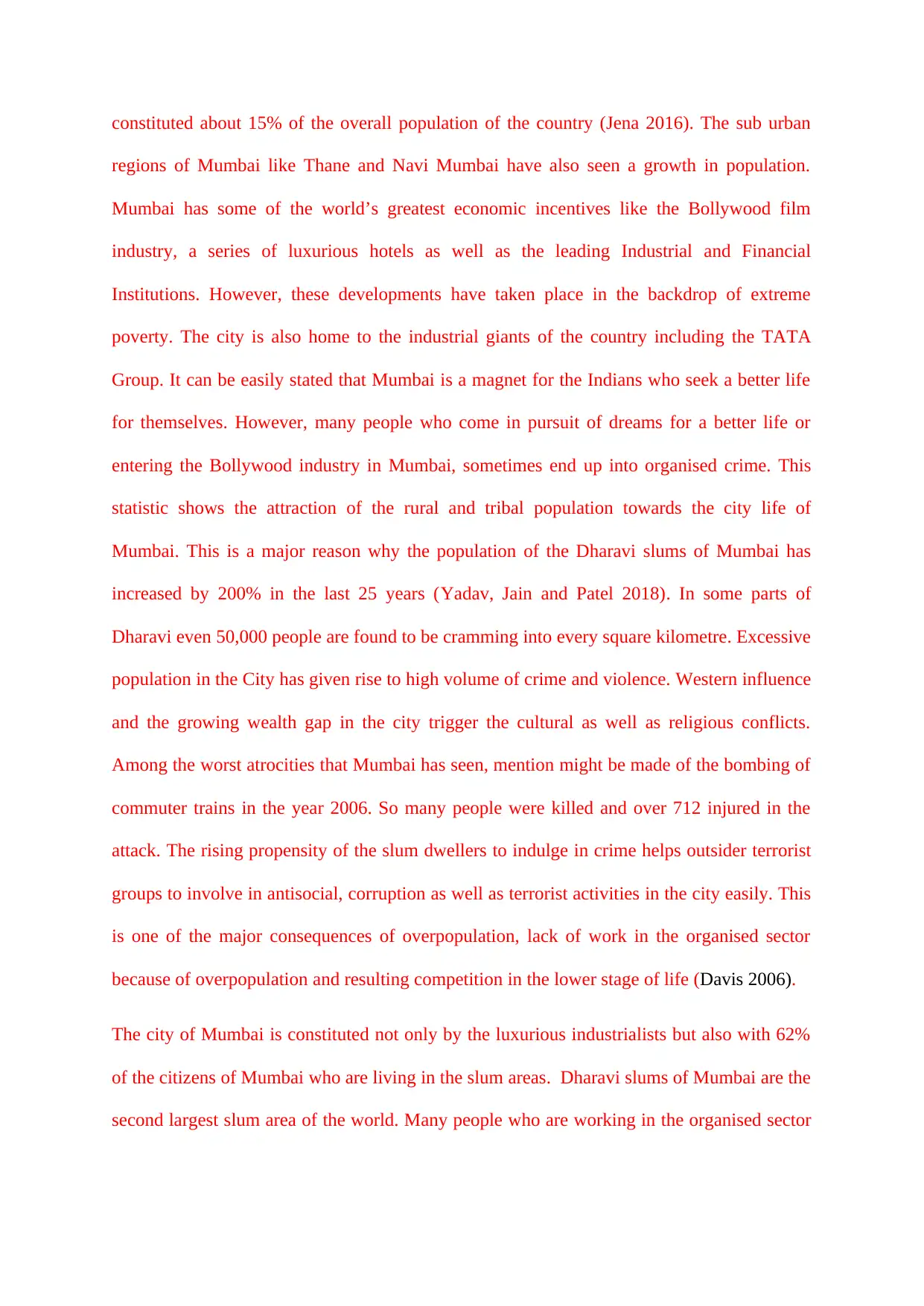
constituted about 15% of the overall population of the country (Jena 2016). The sub urban
regions of Mumbai like Thane and Navi Mumbai have also seen a growth in population.
Mumbai has some of the world’s greatest economic incentives like the Bollywood film
industry, a series of luxurious hotels as well as the leading Industrial and Financial
Institutions. However, these developments have taken place in the backdrop of extreme
poverty. The city is also home to the industrial giants of the country including the TATA
Group. It can be easily stated that Mumbai is a magnet for the Indians who seek a better life
for themselves. However, many people who come in pursuit of dreams for a better life or
entering the Bollywood industry in Mumbai, sometimes end up into organised crime. This
statistic shows the attraction of the rural and tribal population towards the city life of
Mumbai. This is a major reason why the population of the Dharavi slums of Mumbai has
increased by 200% in the last 25 years (Yadav, Jain and Patel 2018). In some parts of
Dharavi even 50,000 people are found to be cramming into every square kilometre. Excessive
population in the City has given rise to high volume of crime and violence. Western influence
and the growing wealth gap in the city trigger the cultural as well as religious conflicts.
Among the worst atrocities that Mumbai has seen, mention might be made of the bombing of
commuter trains in the year 2006. So many people were killed and over 712 injured in the
attack. The rising propensity of the slum dwellers to indulge in crime helps outsider terrorist
groups to involve in antisocial, corruption as well as terrorist activities in the city easily. This
is one of the major consequences of overpopulation, lack of work in the organised sector
because of overpopulation and resulting competition in the lower stage of life (Davis 2006).
The city of Mumbai is constituted not only by the luxurious industrialists but also with 62%
of the citizens of Mumbai who are living in the slum areas. Dharavi slums of Mumbai are the
second largest slum area of the world. Many people who are working in the organised sector
regions of Mumbai like Thane and Navi Mumbai have also seen a growth in population.
Mumbai has some of the world’s greatest economic incentives like the Bollywood film
industry, a series of luxurious hotels as well as the leading Industrial and Financial
Institutions. However, these developments have taken place in the backdrop of extreme
poverty. The city is also home to the industrial giants of the country including the TATA
Group. It can be easily stated that Mumbai is a magnet for the Indians who seek a better life
for themselves. However, many people who come in pursuit of dreams for a better life or
entering the Bollywood industry in Mumbai, sometimes end up into organised crime. This
statistic shows the attraction of the rural and tribal population towards the city life of
Mumbai. This is a major reason why the population of the Dharavi slums of Mumbai has
increased by 200% in the last 25 years (Yadav, Jain and Patel 2018). In some parts of
Dharavi even 50,000 people are found to be cramming into every square kilometre. Excessive
population in the City has given rise to high volume of crime and violence. Western influence
and the growing wealth gap in the city trigger the cultural as well as religious conflicts.
Among the worst atrocities that Mumbai has seen, mention might be made of the bombing of
commuter trains in the year 2006. So many people were killed and over 712 injured in the
attack. The rising propensity of the slum dwellers to indulge in crime helps outsider terrorist
groups to involve in antisocial, corruption as well as terrorist activities in the city easily. This
is one of the major consequences of overpopulation, lack of work in the organised sector
because of overpopulation and resulting competition in the lower stage of life (Davis 2006).
The city of Mumbai is constituted not only by the luxurious industrialists but also with 62%
of the citizens of Mumbai who are living in the slum areas. Dharavi slums of Mumbai are the
second largest slum area of the world. Many people who are working in the organised sector
Paraphrase This Document
Need a fresh take? Get an instant paraphrase of this document with our AI Paraphraser
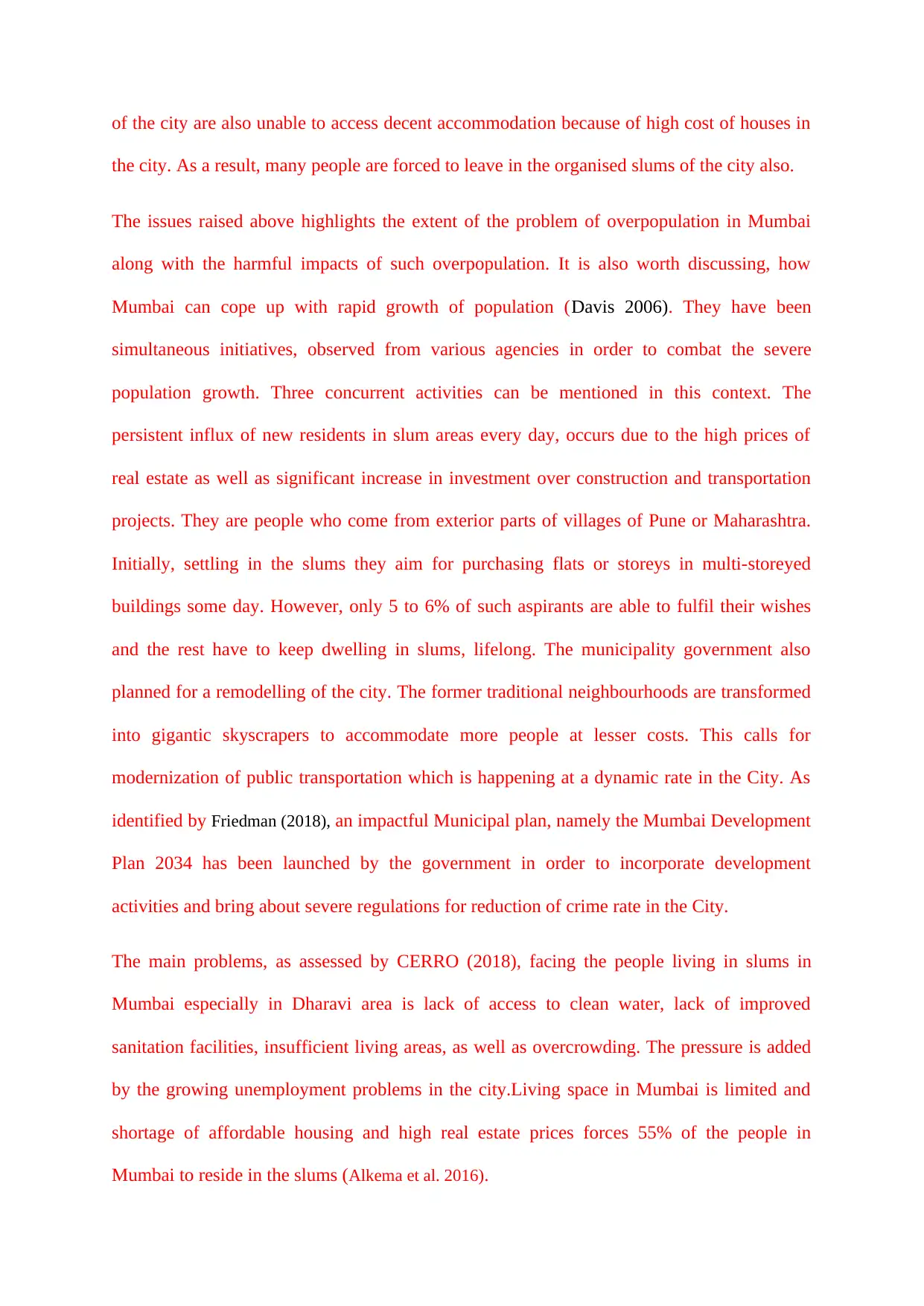
of the city are also unable to access decent accommodation because of high cost of houses in
the city. As a result, many people are forced to leave in the organised slums of the city also.
The issues raised above highlights the extent of the problem of overpopulation in Mumbai
along with the harmful impacts of such overpopulation. It is also worth discussing, how
Mumbai can cope up with rapid growth of population (Davis 2006). They have been
simultaneous initiatives, observed from various agencies in order to combat the severe
population growth. Three concurrent activities can be mentioned in this context. The
persistent influx of new residents in slum areas every day, occurs due to the high prices of
real estate as well as significant increase in investment over construction and transportation
projects. They are people who come from exterior parts of villages of Pune or Maharashtra.
Initially, settling in the slums they aim for purchasing flats or storeys in multi-storeyed
buildings some day. However, only 5 to 6% of such aspirants are able to fulfil their wishes
and the rest have to keep dwelling in slums, lifelong. The municipality government also
planned for a remodelling of the city. The former traditional neighbourhoods are transformed
into gigantic skyscrapers to accommodate more people at lesser costs. This calls for
modernization of public transportation which is happening at a dynamic rate in the City. As
identified by Friedman (2018), an impactful Municipal plan, namely the Mumbai Development
Plan 2034 has been launched by the government in order to incorporate development
activities and bring about severe regulations for reduction of crime rate in the City.
The main problems, as assessed by CERRO (2018), facing the people living in slums in
Mumbai especially in Dharavi area is lack of access to clean water, lack of improved
sanitation facilities, insufficient living areas, as well as overcrowding. The pressure is added
by the growing unemployment problems in the city.Living space in Mumbai is limited and
shortage of affordable housing and high real estate prices forces 55% of the people in
Mumbai to reside in the slums (Alkema et al. 2016).
the city. As a result, many people are forced to leave in the organised slums of the city also.
The issues raised above highlights the extent of the problem of overpopulation in Mumbai
along with the harmful impacts of such overpopulation. It is also worth discussing, how
Mumbai can cope up with rapid growth of population (Davis 2006). They have been
simultaneous initiatives, observed from various agencies in order to combat the severe
population growth. Three concurrent activities can be mentioned in this context. The
persistent influx of new residents in slum areas every day, occurs due to the high prices of
real estate as well as significant increase in investment over construction and transportation
projects. They are people who come from exterior parts of villages of Pune or Maharashtra.
Initially, settling in the slums they aim for purchasing flats or storeys in multi-storeyed
buildings some day. However, only 5 to 6% of such aspirants are able to fulfil their wishes
and the rest have to keep dwelling in slums, lifelong. The municipality government also
planned for a remodelling of the city. The former traditional neighbourhoods are transformed
into gigantic skyscrapers to accommodate more people at lesser costs. This calls for
modernization of public transportation which is happening at a dynamic rate in the City. As
identified by Friedman (2018), an impactful Municipal plan, namely the Mumbai Development
Plan 2034 has been launched by the government in order to incorporate development
activities and bring about severe regulations for reduction of crime rate in the City.
The main problems, as assessed by CERRO (2018), facing the people living in slums in
Mumbai especially in Dharavi area is lack of access to clean water, lack of improved
sanitation facilities, insufficient living areas, as well as overcrowding. The pressure is added
by the growing unemployment problems in the city.Living space in Mumbai is limited and
shortage of affordable housing and high real estate prices forces 55% of the people in
Mumbai to reside in the slums (Alkema et al. 2016).
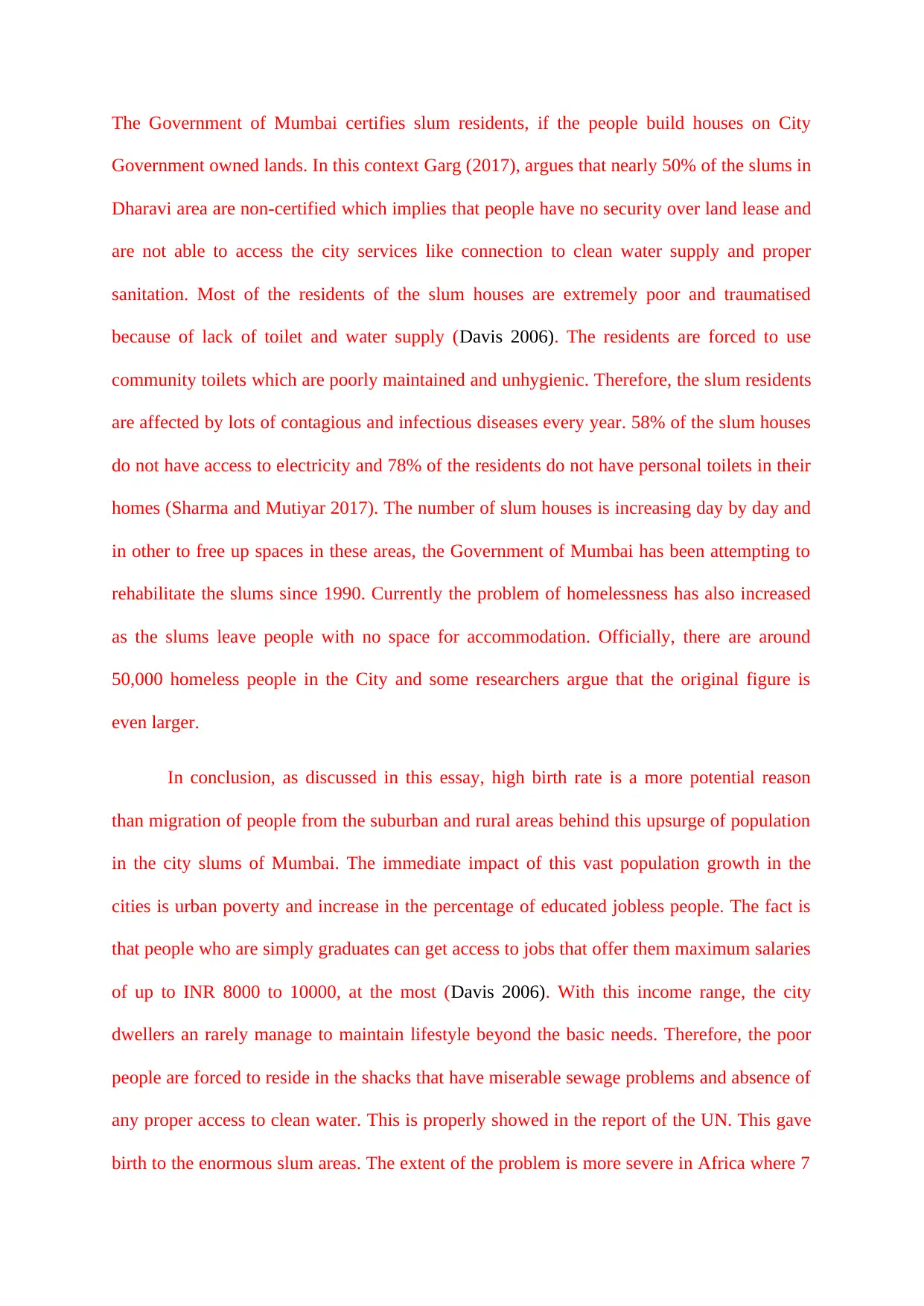
The Government of Mumbai certifies slum residents, if the people build houses on City
Government owned lands. In this context Garg (2017), argues that nearly 50% of the slums in
Dharavi area are non-certified which implies that people have no security over land lease and
are not able to access the city services like connection to clean water supply and proper
sanitation. Most of the residents of the slum houses are extremely poor and traumatised
because of lack of toilet and water supply (Davis 2006). The residents are forced to use
community toilets which are poorly maintained and unhygienic. Therefore, the slum residents
are affected by lots of contagious and infectious diseases every year. 58% of the slum houses
do not have access to electricity and 78% of the residents do not have personal toilets in their
homes (Sharma and Mutiyar 2017). The number of slum houses is increasing day by day and
in other to free up spaces in these areas, the Government of Mumbai has been attempting to
rehabilitate the slums since 1990. Currently the problem of homelessness has also increased
as the slums leave people with no space for accommodation. Officially, there are around
50,000 homeless people in the City and some researchers argue that the original figure is
even larger.
In conclusion, as discussed in this essay, high birth rate is a more potential reason
than migration of people from the suburban and rural areas behind this upsurge of population
in the city slums of Mumbai. The immediate impact of this vast population growth in the
cities is urban poverty and increase in the percentage of educated jobless people. The fact is
that people who are simply graduates can get access to jobs that offer them maximum salaries
of up to INR 8000 to 10000, at the most (Davis 2006). With this income range, the city
dwellers an rarely manage to maintain lifestyle beyond the basic needs. Therefore, the poor
people are forced to reside in the shacks that have miserable sewage problems and absence of
any proper access to clean water. This is properly showed in the report of the UN. This gave
birth to the enormous slum areas. The extent of the problem is more severe in Africa where 7
Government owned lands. In this context Garg (2017), argues that nearly 50% of the slums in
Dharavi area are non-certified which implies that people have no security over land lease and
are not able to access the city services like connection to clean water supply and proper
sanitation. Most of the residents of the slum houses are extremely poor and traumatised
because of lack of toilet and water supply (Davis 2006). The residents are forced to use
community toilets which are poorly maintained and unhygienic. Therefore, the slum residents
are affected by lots of contagious and infectious diseases every year. 58% of the slum houses
do not have access to electricity and 78% of the residents do not have personal toilets in their
homes (Sharma and Mutiyar 2017). The number of slum houses is increasing day by day and
in other to free up spaces in these areas, the Government of Mumbai has been attempting to
rehabilitate the slums since 1990. Currently the problem of homelessness has also increased
as the slums leave people with no space for accommodation. Officially, there are around
50,000 homeless people in the City and some researchers argue that the original figure is
even larger.
In conclusion, as discussed in this essay, high birth rate is a more potential reason
than migration of people from the suburban and rural areas behind this upsurge of population
in the city slums of Mumbai. The immediate impact of this vast population growth in the
cities is urban poverty and increase in the percentage of educated jobless people. The fact is
that people who are simply graduates can get access to jobs that offer them maximum salaries
of up to INR 8000 to 10000, at the most (Davis 2006). With this income range, the city
dwellers an rarely manage to maintain lifestyle beyond the basic needs. Therefore, the poor
people are forced to reside in the shacks that have miserable sewage problems and absence of
any proper access to clean water. This is properly showed in the report of the UN. This gave
birth to the enormous slum areas. The extent of the problem is more severe in Africa where 7
⊘ This is a preview!⊘
Do you want full access?
Subscribe today to unlock all pages.

Trusted by 1+ million students worldwide
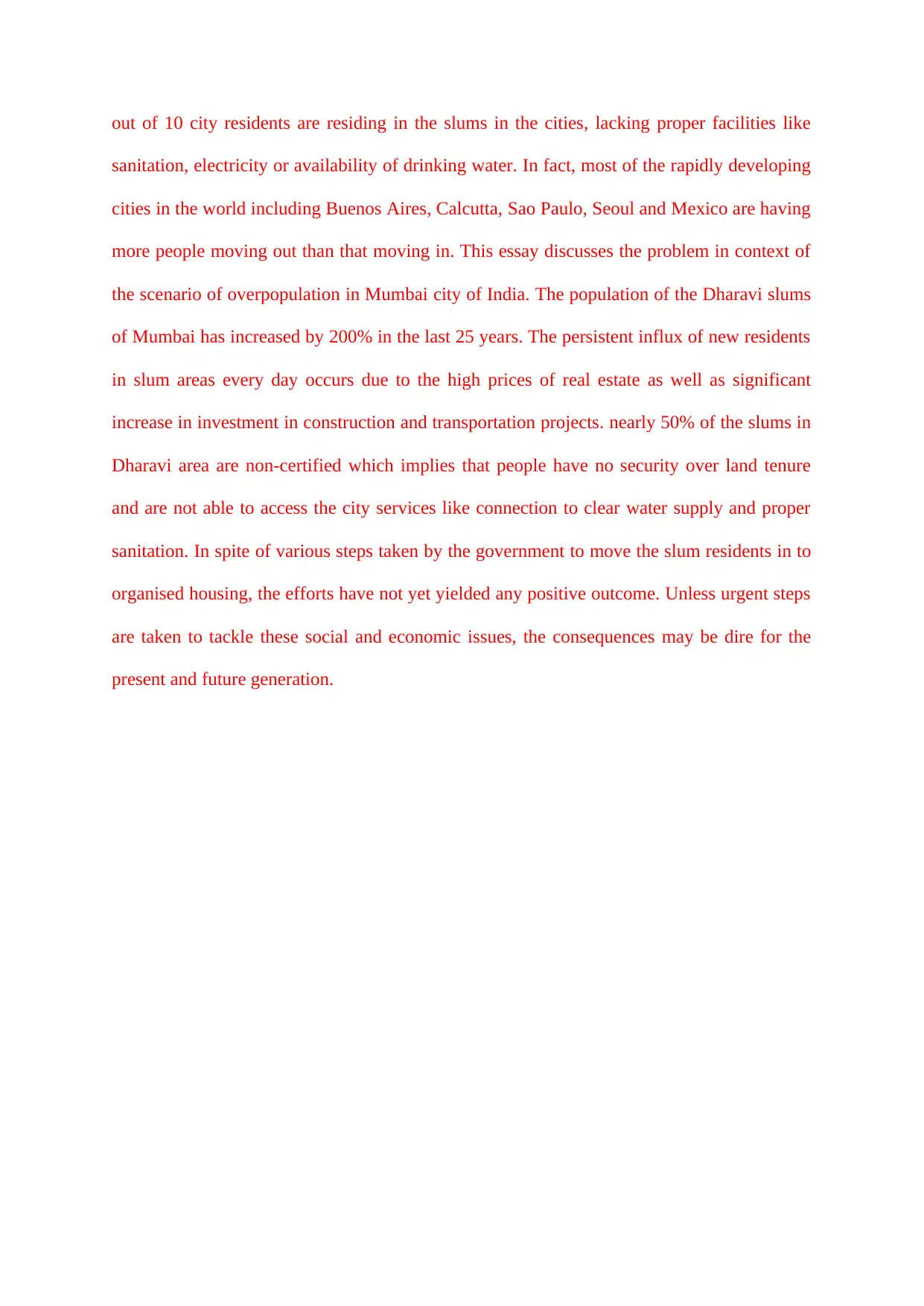
out of 10 city residents are residing in the slums in the cities, lacking proper facilities like
sanitation, electricity or availability of drinking water. In fact, most of the rapidly developing
cities in the world including Buenos Aires, Calcutta, Sao Paulo, Seoul and Mexico are having
more people moving out than that moving in. This essay discusses the problem in context of
the scenario of overpopulation in Mumbai city of India. The population of the Dharavi slums
of Mumbai has increased by 200% in the last 25 years. The persistent influx of new residents
in slum areas every day occurs due to the high prices of real estate as well as significant
increase in investment in construction and transportation projects. nearly 50% of the slums in
Dharavi area are non-certified which implies that people have no security over land tenure
and are not able to access the city services like connection to clear water supply and proper
sanitation. In spite of various steps taken by the government to move the slum residents in to
organised housing, the efforts have not yet yielded any positive outcome. Unless urgent steps
are taken to tackle these social and economic issues, the consequences may be dire for the
present and future generation.
sanitation, electricity or availability of drinking water. In fact, most of the rapidly developing
cities in the world including Buenos Aires, Calcutta, Sao Paulo, Seoul and Mexico are having
more people moving out than that moving in. This essay discusses the problem in context of
the scenario of overpopulation in Mumbai city of India. The population of the Dharavi slums
of Mumbai has increased by 200% in the last 25 years. The persistent influx of new residents
in slum areas every day occurs due to the high prices of real estate as well as significant
increase in investment in construction and transportation projects. nearly 50% of the slums in
Dharavi area are non-certified which implies that people have no security over land tenure
and are not able to access the city services like connection to clear water supply and proper
sanitation. In spite of various steps taken by the government to move the slum residents in to
organised housing, the efforts have not yet yielded any positive outcome. Unless urgent steps
are taken to tackle these social and economic issues, the consequences may be dire for the
present and future generation.
Paraphrase This Document
Need a fresh take? Get an instant paraphrase of this document with our AI Paraphraser
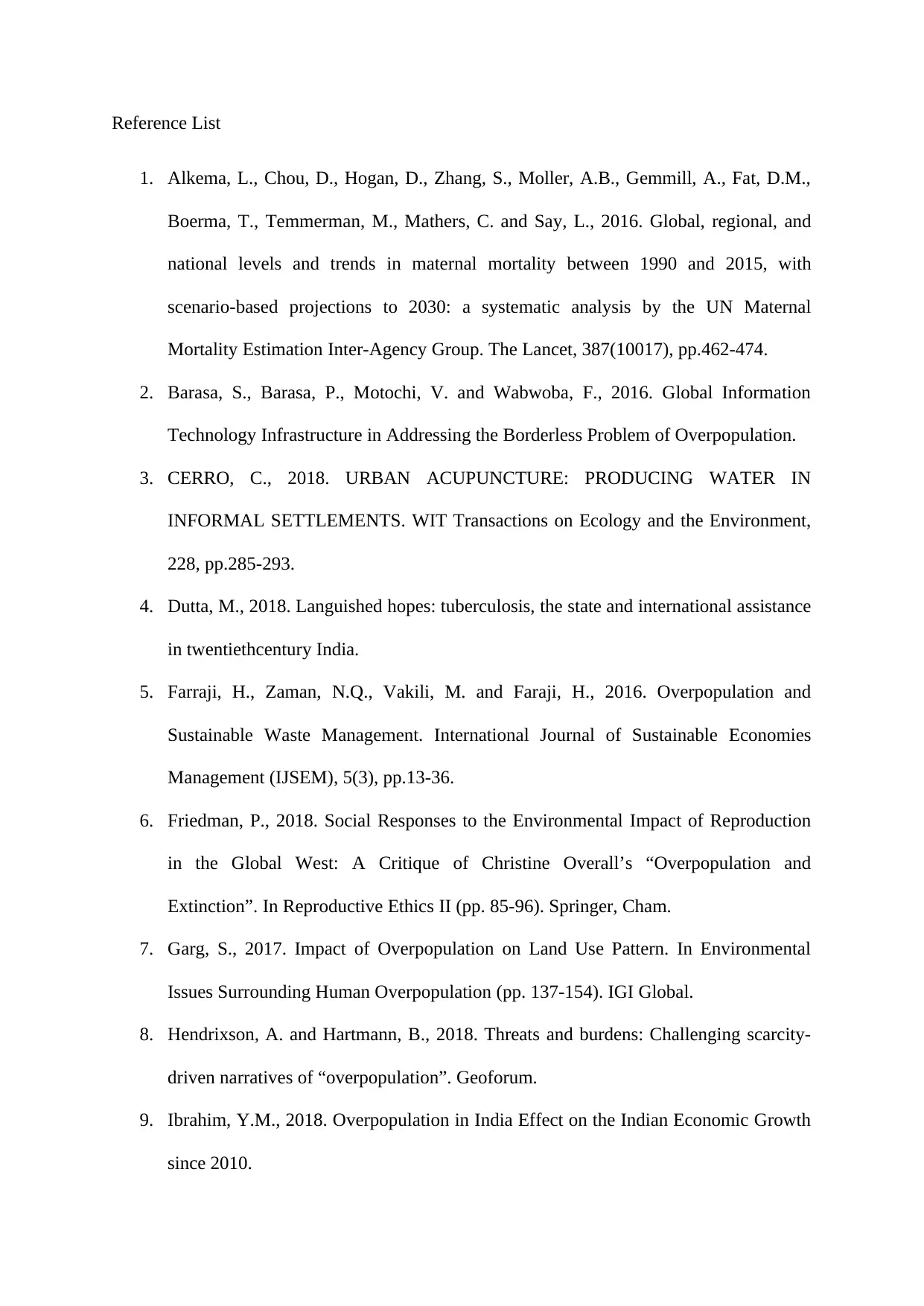
Reference List
1. Alkema, L., Chou, D., Hogan, D., Zhang, S., Moller, A.B., Gemmill, A., Fat, D.M.,
Boerma, T., Temmerman, M., Mathers, C. and Say, L., 2016. Global, regional, and
national levels and trends in maternal mortality between 1990 and 2015, with
scenario-based projections to 2030: a systematic analysis by the UN Maternal
Mortality Estimation Inter-Agency Group. The Lancet, 387(10017), pp.462-474.
2. Barasa, S., Barasa, P., Motochi, V. and Wabwoba, F., 2016. Global Information
Technology Infrastructure in Addressing the Borderless Problem of Overpopulation.
3. CERRO, C., 2018. URBAN ACUPUNCTURE: PRODUCING WATER IN
INFORMAL SETTLEMENTS. WIT Transactions on Ecology and the Environment,
228, pp.285-293.
4. Dutta, M., 2018. Languished hopes: tuberculosis, the state and international assistance
in twentiethcentury India.
5. Farraji, H., Zaman, N.Q., Vakili, M. and Faraji, H., 2016. Overpopulation and
Sustainable Waste Management. International Journal of Sustainable Economies
Management (IJSEM), 5(3), pp.13-36.
6. Friedman, P., 2018. Social Responses to the Environmental Impact of Reproduction
in the Global West: A Critique of Christine Overall’s “Overpopulation and
Extinction”. In Reproductive Ethics II (pp. 85-96). Springer, Cham.
7. Garg, S., 2017. Impact of Overpopulation on Land Use Pattern. In Environmental
Issues Surrounding Human Overpopulation (pp. 137-154). IGI Global.
8. Hendrixson, A. and Hartmann, B., 2018. Threats and burdens: Challenging scarcity-
driven narratives of “overpopulation”. Geoforum.
9. Ibrahim, Y.M., 2018. Overpopulation in India Effect on the Indian Economic Growth
since 2010.
1. Alkema, L., Chou, D., Hogan, D., Zhang, S., Moller, A.B., Gemmill, A., Fat, D.M.,
Boerma, T., Temmerman, M., Mathers, C. and Say, L., 2016. Global, regional, and
national levels and trends in maternal mortality between 1990 and 2015, with
scenario-based projections to 2030: a systematic analysis by the UN Maternal
Mortality Estimation Inter-Agency Group. The Lancet, 387(10017), pp.462-474.
2. Barasa, S., Barasa, P., Motochi, V. and Wabwoba, F., 2016. Global Information
Technology Infrastructure in Addressing the Borderless Problem of Overpopulation.
3. CERRO, C., 2018. URBAN ACUPUNCTURE: PRODUCING WATER IN
INFORMAL SETTLEMENTS. WIT Transactions on Ecology and the Environment,
228, pp.285-293.
4. Dutta, M., 2018. Languished hopes: tuberculosis, the state and international assistance
in twentiethcentury India.
5. Farraji, H., Zaman, N.Q., Vakili, M. and Faraji, H., 2016. Overpopulation and
Sustainable Waste Management. International Journal of Sustainable Economies
Management (IJSEM), 5(3), pp.13-36.
6. Friedman, P., 2018. Social Responses to the Environmental Impact of Reproduction
in the Global West: A Critique of Christine Overall’s “Overpopulation and
Extinction”. In Reproductive Ethics II (pp. 85-96). Springer, Cham.
7. Garg, S., 2017. Impact of Overpopulation on Land Use Pattern. In Environmental
Issues Surrounding Human Overpopulation (pp. 137-154). IGI Global.
8. Hendrixson, A. and Hartmann, B., 2018. Threats and burdens: Challenging scarcity-
driven narratives of “overpopulation”. Geoforum.
9. Ibrahim, Y.M., 2018. Overpopulation in India Effect on the Indian Economic Growth
since 2010.
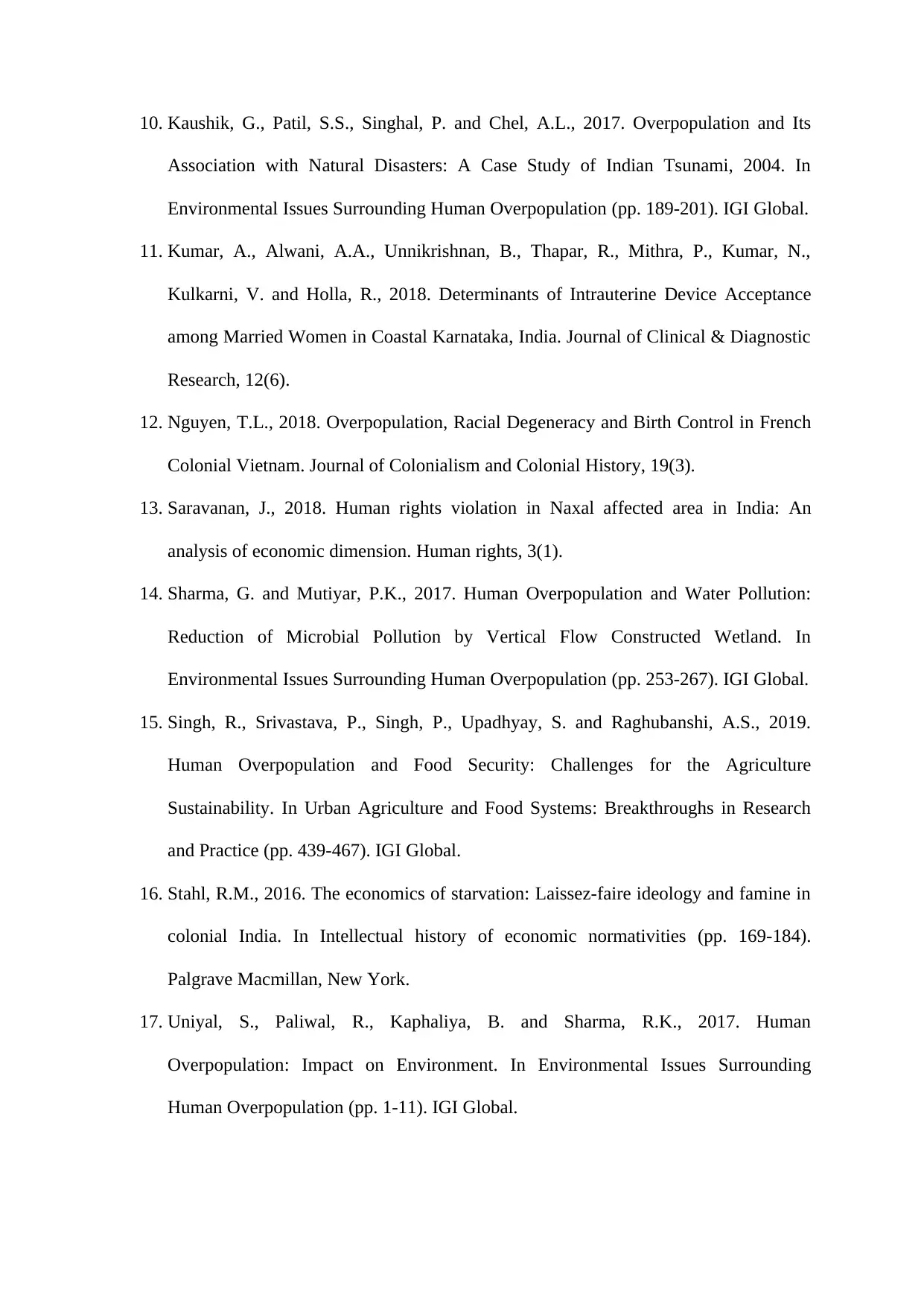
10. Kaushik, G., Patil, S.S., Singhal, P. and Chel, A.L., 2017. Overpopulation and Its
Association with Natural Disasters: A Case Study of Indian Tsunami, 2004. In
Environmental Issues Surrounding Human Overpopulation (pp. 189-201). IGI Global.
11. Kumar, A., Alwani, A.A., Unnikrishnan, B., Thapar, R., Mithra, P., Kumar, N.,
Kulkarni, V. and Holla, R., 2018. Determinants of Intrauterine Device Acceptance
among Married Women in Coastal Karnataka, India. Journal of Clinical & Diagnostic
Research, 12(6).
12. Nguyen, T.L., 2018. Overpopulation, Racial Degeneracy and Birth Control in French
Colonial Vietnam. Journal of Colonialism and Colonial History, 19(3).
13. Saravanan, J., 2018. Human rights violation in Naxal affected area in India: An
analysis of economic dimension. Human rights, 3(1).
14. Sharma, G. and Mutiyar, P.K., 2017. Human Overpopulation and Water Pollution:
Reduction of Microbial Pollution by Vertical Flow Constructed Wetland. In
Environmental Issues Surrounding Human Overpopulation (pp. 253-267). IGI Global.
15. Singh, R., Srivastava, P., Singh, P., Upadhyay, S. and Raghubanshi, A.S., 2019.
Human Overpopulation and Food Security: Challenges for the Agriculture
Sustainability. In Urban Agriculture and Food Systems: Breakthroughs in Research
and Practice (pp. 439-467). IGI Global.
16. Stahl, R.M., 2016. The economics of starvation: Laissez-faire ideology and famine in
colonial India. In Intellectual history of economic normativities (pp. 169-184).
Palgrave Macmillan, New York.
17. Uniyal, S., Paliwal, R., Kaphaliya, B. and Sharma, R.K., 2017. Human
Overpopulation: Impact on Environment. In Environmental Issues Surrounding
Human Overpopulation (pp. 1-11). IGI Global.
Association with Natural Disasters: A Case Study of Indian Tsunami, 2004. In
Environmental Issues Surrounding Human Overpopulation (pp. 189-201). IGI Global.
11. Kumar, A., Alwani, A.A., Unnikrishnan, B., Thapar, R., Mithra, P., Kumar, N.,
Kulkarni, V. and Holla, R., 2018. Determinants of Intrauterine Device Acceptance
among Married Women in Coastal Karnataka, India. Journal of Clinical & Diagnostic
Research, 12(6).
12. Nguyen, T.L., 2018. Overpopulation, Racial Degeneracy and Birth Control in French
Colonial Vietnam. Journal of Colonialism and Colonial History, 19(3).
13. Saravanan, J., 2018. Human rights violation in Naxal affected area in India: An
analysis of economic dimension. Human rights, 3(1).
14. Sharma, G. and Mutiyar, P.K., 2017. Human Overpopulation and Water Pollution:
Reduction of Microbial Pollution by Vertical Flow Constructed Wetland. In
Environmental Issues Surrounding Human Overpopulation (pp. 253-267). IGI Global.
15. Singh, R., Srivastava, P., Singh, P., Upadhyay, S. and Raghubanshi, A.S., 2019.
Human Overpopulation and Food Security: Challenges for the Agriculture
Sustainability. In Urban Agriculture and Food Systems: Breakthroughs in Research
and Practice (pp. 439-467). IGI Global.
16. Stahl, R.M., 2016. The economics of starvation: Laissez-faire ideology and famine in
colonial India. In Intellectual history of economic normativities (pp. 169-184).
Palgrave Macmillan, New York.
17. Uniyal, S., Paliwal, R., Kaphaliya, B. and Sharma, R.K., 2017. Human
Overpopulation: Impact on Environment. In Environmental Issues Surrounding
Human Overpopulation (pp. 1-11). IGI Global.
⊘ This is a preview!⊘
Do you want full access?
Subscribe today to unlock all pages.

Trusted by 1+ million students worldwide
1 out of 13
Related Documents
Your All-in-One AI-Powered Toolkit for Academic Success.
+13062052269
info@desklib.com
Available 24*7 on WhatsApp / Email
![[object Object]](/_next/static/media/star-bottom.7253800d.svg)
Unlock your academic potential
Copyright © 2020–2025 A2Z Services. All Rights Reserved. Developed and managed by ZUCOL.





